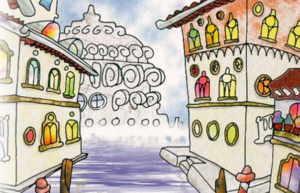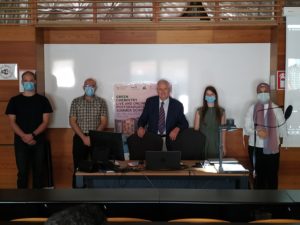DAY 1 > DAY 2 > DAY 3 > DAY 4 > DAY 5

DAY 1
 On July 5, 2021, the Postgraduate Summer School on Green Chemistry 2021 kicked off with a number of lectures on Green Chemistry for online and in-person students. Particularly,
On July 5, 2021, the Postgraduate Summer School on Green Chemistry 2021 kicked off with a number of lectures on Green Chemistry for online and in-person students. Particularly,
Professor Jean-Marie Lehn from the University of Strasbourg, who received the Nobel Prize in Chemistry in 1987, opened the first scientific session in the morning by giving a very inspiring lecture on “Perspectives in Chemistry: Molecular-Supramolecular-Adaptive Chemistry” to students.
Professor Pietro Tundo showed how dimethyl carbonate complies with Green Chemistry and made a comparison among reaction mechanisms and energy profiles in esters and carbonates.
Professor Buxing Han gave an insightful talk on the use of biomass and CO2 as carbon source to produce fuels and value-added chemicals.
As an entire world is going through COVID-19 pandemic, Dr. Elena Pomari from IRCCS Sacro Cuore Don Calabria Hospital, Italy, addressed the important role of green chemistry in designing cures, vaccines and various techniques for viral detection, including molecular methods such as reverse transcription polymerase chain reaction, droplet digital PCR, whole genome sequencing, tomography, optical biosensors and point-of-care diagnostics. The first day of the summer school ended successfully by online and in-person poster presentations.


DAY 2
On the second day of the Postgraduate Summer School on Green Chemistry 2021, very inspiring lectures were given by distinguished scientists known in the field of Green Chemistry. As an example:
Prof. Michael Grätzel from École Polytechnique Fédérale de Lausanne, Switzerland, who is known for the dye-sensitized solar cell “Graetzel cell”, introduced mesoscopic photosystems that convert sunlight very efficiently to electricity and chemical fuels mimicking natural photosynthesis and new concepts to realize highly efficient generation of hydrogen and reduction of carbon dioxide to ethylene by sunlight using water as electron source.
Prof. Haoran Li from Zhejiang University, China, who scaled up several chemical and pharmaceutical processes, including vitamin E, A, D3, H and carotenoids, demonstrated mechanisms and applications of aerobic oxidation (potential green process) in vitamin industry, including (i) the oxidation of beta-isophoron in petrochemical process for vitamin E production, (ii) the oxidation of 2,3,6-trimethylphenol in coal chemical process for vitamin E production, and (iii) the oxidation of acetyl-cholesterol in vitamin D3 production.
Prof. Konstantinos Triantafyllidis from Aristotle University of Thessaloniki, Greece, gave an insightful lecture on adding value to biorefinery and pulp industry side-streams: lignin valorization to fuels, chemicals and polymers as lignin is still under-utilized compared to the carbohydrate fractions of biomass, being mainly burnt to cover the heat and power needs of the main process.
The second day of the Summer School finished successfully by 29 online and 13 in-person poster presentations.
DAY 3
 On the third day of the Postgraduate Summer School on Green Chemistry 2021, the Awards by PhosAgro to the best four posters presented in person (500 € each) were given to two female and two male participants:
On the third day of the Postgraduate Summer School on Green Chemistry 2021, the Awards by PhosAgro to the best four posters presented in person (500 € each) were given to two female and two male participants:
Manar Hazaa from The American University in Cairo, Egypt
Monika Horvat from the University of Ljubljana, Slovenia
Mohammed Kadhom from Alkarkh University of Science, Iraq
Felipe Sanchez Bragagnolo from São Paulo State University, Brazil
There were two fascinating lectures:
Dr. Alessandro Martinis, Vice President of Danieli & C. S.p.A., Italy, demonstrated the impact of CO2 emission from the iron and steel industry due to the extensive use of coal and EU initiatives to reduce CO2 emission; this industry is responsible for around 8% of the total greenhouse gas emissions and is one of the “hard to abate” sectors.
AND the new low-carbon technology, which is the world’s most advanced technology for reduction of CO2 emission, for the iron and steel industry using H2 as fuel and reductant.
Prof. Carlo Barbante from University Ca’Foscari of Venice, Italy, presented the impact of global warming and its consequences on climate change, and the developed mass spectrometry-based advanced analytical methodology for trace and ultra-trace determinations in environmental and biological matrices, chemical imaging analysis, long-term paleoclimate and atmospheric chemistry from ice cores, quaternary climate, heavy metals and organic pollutants in polar and temperate ice and snow, paleo-fires reconstruction through ice and lake sediment records.
The day of the Summer School ended successfully by visiting magnificent Gallerie dell’Accademia, which is one of the major Italian museums and is dedicated to the Italian Renaissance.
DAY 4
On the four day of the Postgraduate Summer School on Green Chemistry 2021, there were a number of insightful lectures. including:
Prof. Krzysztof Matyjaszewski from Carnegie Mellon University, United States, is most well-known for his extraordinary work on developing atom transfer radical polymerization (ATRP) and other controlled radical and ionic polymerization techniques to synthesize various well-defined polymers with precisely controlled molecular architecture with designed shape, composition and functionality. He delivered an insightful lecture on developing various techniques for the regeneration of the catalytic systems, including green chemical reagents such as ascorbic acid or sugars but also external stimuli: electrical current, light, mechanical forces and ultrasound, to combat unavoidable radical termination.
DAY 5
On the fifth day of the Postgraduate Summer School on Green Chemistry 2021, several interesting lectures were delivered:
Prof. Burkhard König from the University of Regensburg, Germany, delivered an insightful lecture on “Using visible light for more sustainable organic synthesis”, which addressed novel green chemistry approaches for the photocatalytic activation of stronger bonds by a visible light photon with small energy, the generation of reactive anions by a visible light photon, and the synthesis of organic semiconductors as a valid alternative for less stable metal complexes and organic dyes and other future challenges.
Prof. James Clark from the University of York, United Kingdom, given an inspiring lecture on “Bio-based solvents and their selection”. His lecture critically reviewed the alternative solvents that are available to replace toxic or otherwise unacceptable solvents and took a close look at the emergence of bio-based solvents and how they could fit into a greener solvent landscape as well as support the growing bio-economy movement.
Sandra Averous-Monnery, Programme Officer at the United Nations Environment Programme (UNEP) presented the UNEP’s Green and Sustainable Chemistry Framework Manual that contains 10 green and sustainable chemistry objectives, addressed various facets of green and sustainable chemistry with the intention to foster general learning, reflection and scaling-up action. She highlighted the general information from the results of the Survey for Green Chemistry Summer School participants. This completed survey will aid UNEP in assessing the current green and sustainable chemistry landscape around the world.
Professor Emeritus Neil Coville from the University of the Witwatersrand, South Africa, announced the seven best posters presented online:
Caterina Rovegno, ISOF–CNR, Italy
Stephanie Fraser, University of KwaZulu-Natal, South Africa
Selzer Solange Mailen, National University of Cordoba, Argentina
Giulia Rando, ISMN–CNR, Italy
Gabriele Soriano, University of Naples Federico II, Italy
Yanru Zhang, Sichuan University, China
Luca Filippi, Karlsruhe Institute of Technology, Germany
After closing remarks given by Prof. Christopher Brett (IUPAC President), the Postgraduate Summer School on Green Chemistry 2021 was officially closed by Prof. Pietro Tundo (President of Green Sciences for Sustainable Development (GSSD) Foundation).
See YOU Next Time!
Courtesy by GSSD Foundation
First post 6 July 2021; last update 10 July 2021








